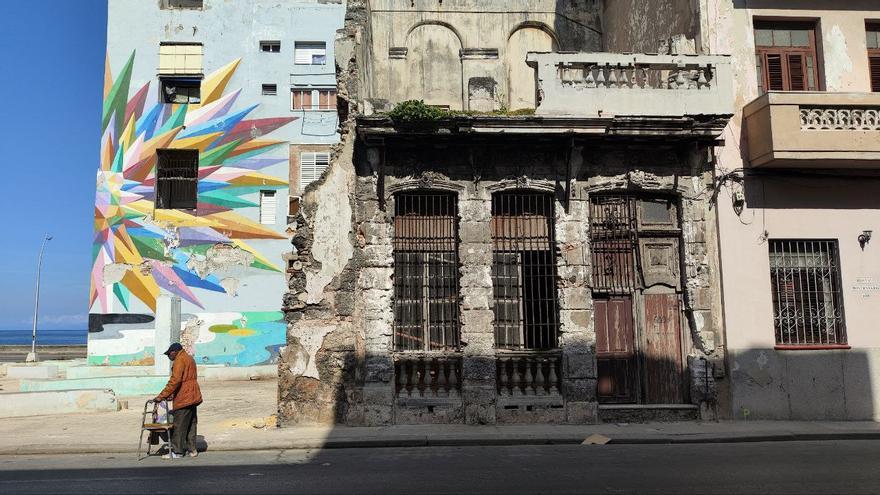
![]() 14ymedio, Juan Diego Rodríguez, Havana, December 1, 2023 — The colorful paint behind the building on the corner of Campanario and Malecón, in Havana, is only there to hide the hole left by a collapse on the San Lázaro side. The same function is fulfilled by a kind of park – if you can call it that, a piece of gray cement land, bare of trees – where a building once stood.
14ymedio, Juan Diego Rodríguez, Havana, December 1, 2023 — The colorful paint behind the building on the corner of Campanario and Malecón, in Havana, is only there to hide the hole left by a collapse on the San Lázaro side. The same function is fulfilled by a kind of park – if you can call it that, a piece of gray cement land, bare of trees – where a building once stood.
However, it cannot be hidden, because, attached to the adjacent number, there are remains of the façade. As if they had purposely wanted to record one more trace of the ruin of Central Havana.
With its back to the avenue that faces the sea, whose buildings do, from time to time, have the good fortune to receive maintenance, as it is an obligatory gateway for tourists and foreign guests of the regime, San Lázaro is one of the most forgotten streets in the capital. Here it doesn’t matter if saltpeter, scarcity and apathy eat into the facades until they collapse.
It wasn’t always like this. This same corner is halfway between two arteries that once bustled with commerce and exuded luxury: Belascoaín, on the one hand, and Galiano, on the other.
Next to Belascoaín and San Lázaro is one of the emblematic places of the municipality, Parque Maceo, where the Torreón de San Lázaro is located, a 17th century lookout point, and where the children of Centro Habana could escape from their tiny and overcrowded homes to run, play, ride a bike, scrape their knees.
Today, fewer and fewer toddlers are seen in the area. The birth rate is reduced by the migratory exodus and hopelessness. There are no longer activities or children’s shows
The place is also considered a hub because several neighborhoods converge there: San Leopoldo, Pueblo Nuevo and Cayo Hueso.
Today, fewer and fewer toddlers are seen in the area. The birth rate is reduced by the migratory exodus and hopelessness. There are no longer children’s activities or shows in the park. The cafeteria that opened in the nineties during the first dollarization and was quite busy, closed years ago. The bad reputation of the basic secondary school, right there in Belascoaín and San Lázaro, of marginality, bullying, violence and drugs, has spread throughout all these streets.
At the other fundamental point, Galiano, little remains of its previous commercial heart. On the corner with San Lázaro, the Deauville hotel is not remembered for having been a cabaret and casino owned by gangsters – and correspondingly looted with the outbreak of the Revolution – but for one of the focuses of the then historic protests of August 1994 known as the Maleconazo.
That area is saved by already having one foot in Old Havana, pampered by the Historian’s Office, international donations and tourists.
But travelers do not approach San Lázaro and Campanario. Children are no longer heard in the streets. An old man walks past the cement park creeping with a walker. A corner fallen into disgrace, like the entire Island.
____________
COLLABORATE WITH OUR WORK: The 14ymedio team is committed to practicing serious journalism that reflects Cuba’s reality in all its depth. Thank you for joining us on this long journey. We invite you to continue supporting us by becoming a member of 14ymedio now. Together we can continue transforming journalism in Cuba.
